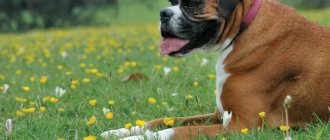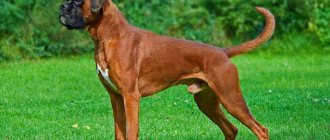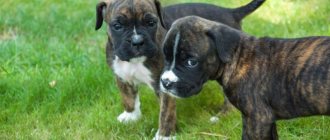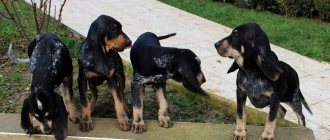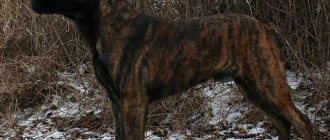If you need not only a loyal friend, but also an excellent protector, then the German Boxer dog breed is what you need. From the photo of the German boxer it is clear that this breed of dog was simply created to protect humans.
In many cases, this type of dog is used for police service and private security. However, despite its muscular body and intimidating appearance, this breed has a kind character. This means that such a dog is capable of becoming a loyal friend and comrade for its owner.
Breed description, standards and appearance
The modern German boxer is a large, muscular dog with strong bones. It is harmoniously built, so it does not look overly massive or clumsy. This is how FCI standard No. 144 characterizes it:
| Become | Characteristic |
| Head | Proportional to the body, dry, without wrinkles. When the dog is alert, small wrinkles may appear on the forehead |
| Muzzle | Large and voluminous, close in shape to a square |
| Nose | Wide, black, slightly upturned |
| Jaws | Strong. Acceptable overbite - undershot |
| Eyes | Small, not planted deeply, but not protruding either. Iris pigmentation – dark |
| Ears | They sit high. In a relaxed state, touch the cheekbones |
| Neck | Powerful, dry, with well-developed muscles. Has an arched shape |
| Torso | The ratio of length to height is 1:1. The withers are clearly visible, the back and loin are wide, the chest is deep |
| Tail | Narrow, set high. Previously subject to docking, now it is left in its natural form |
| Limbs | Set wide and parallel. Elbows pressed to the body. The paws are small, the hind legs are slightly longer than the front ones. |
Important. Dogs with obvious physical and behavioral abnormalities will be disqualified.
The German breed standard provides for the following physical parameters of animals:
- height at withers – 57-63 cm for boys, 53-59 cm for girls;
- The weight of a German boxer dog is from 30 kg with a height of about 60 cm for males, from 25 kg with a height of about 56 cm for females.
Important. The weight of the pet should not be allowed to greatly exceed the permissible limits. The extra pounds negatively affect his health.
Types of boxers
Breeders and experts distinguish within-breed types of boxers:
- German is the only recognized type; animals have excellent protective qualities, a balanced character and boundless devotion;
- American - breeding work was carried out in the USA after World War II; Only an experienced dog breeder can see the differences from standard Boxers: American Boxers have a slightly lighter build and a less massive head.
You can read about whether Boxers should have their ears and tail cropped in the article “Why is this necessary and is it possible to do without the procedure?”
There are also unofficial types of boxers that are not regulated in any way by the standard, these are the so-called “mini boxers”:
- bullbocker stuff;
- bullboxer;
- boston terrier
These types of boxers are mestizos obtained with the participation of other breeds. The dwarf version of the breed is perfect for keeping in a small apartment.
This is interesting. The German Boxer, like the English, French and American Bulldogs, is a brachycephalic dog. It cannot be transported on airplanes due to the specific structure of the respiratory system. The ban was introduced after the death of a French bulldog on board an airplane.
Color
The German Boxer has a short and coarse coat. It does not puff up, but fits snugly to the body. The breed standard allows the following colors:
- brindle boxer - stripes of dark or black color, with clear boundaries, scattered on a reddish background; The presence of white marks is not prohibited;
- red boxer - any shade of red is acceptable: from light fawn to red-brown, but preference is given to medium shades of red and red.
Other colors are not recognized. Varieties such as the white or black German boxer are outside the breed.
Mating
- Dogs become sexually mature at 18-20 months. By this time, the bitch should already be in her third heat. Dogs can be bred for 10-15 days; it is important to select such pets so that their qualities complement each other and are passed on to the offspring in the right form.
- It is important to introduce boxers and walk them together . Not all individuals accept each other. The bitch should be open and flirt with the male. After this, it is customary to take them to the boy’s territory, but if the female is restless, it is important to change the place.
- For the first time, you can invite a specialist who will help both the dog and the owner. He will explain the rules of mating and show how to help your pet.
- Breeders must hold the bitch and help the dog. After entering the “castle,” you cannot let your pets go; it is better to hold on for the next 30-40 minutes. The mating is repeated after a couple of days.
Character and behavior
The German Boxer dog is very balanced, obedient, brave and loyal. She is distinguished by honesty, lack of cunning and deceit. Her temperament combines such traits as tenderness towards her family and distrust of strangers, friendliness in games and fearlessness in attack.
Representatives of this dog breed are easy to train, but due to their character traits they may not immediately respond to commands. You need to be patient and under no circumstances use brute physical force. It is important to interest the German boxer. Then a representative of this breed will gladly perform all the required actions.
Important. Due to insufficient socialization, Boxers conflict with their relatives. But this flaw can be easily corrected with competent education.
Attitude towards children
Boxer dog and children get along great. An energetic pet is interested in spending time playing active games, and teenagers are interested in communicating with a friendly dog. To avoid conflicts, you must:
- properly socialize the dog, show it that children are just like family members who need to be taken care of and protected;
- Tell your child about the rules of behavior with animals, teach them to understand dog body language.
If these rules are followed, a well-mannered German boxer can become an excellent nanny for children.
Watchdog and security qualities
German Boxer dogs are excellent guard dogs. They are wary of strangers, but at the same time take the responsibilities assigned to them responsibly. But they do not show causeless aggression - the dog can rush at a person only if there is a clear threat. Strong and hardy dogs are actively involved in guard duty and are “called upon” to work in the police.
Important. Cowardly or aggressive German Boxer dogs are discarded. They do not participate in exhibitions and matings.
Application
The German Boxer is an excellent companion that does not require special conditions.
The dog feels great both in an apartment and in a country house, living in a booth or enclosure .
Thanks to its intelligence and easy trainability, it is also an excellent working dog.
She performed well, just like Groenendael , “cooperating” with the police and security agencies.
Can serve as a sensitive guide for the blind.
The Boxer is highly trainable and trainable.
How to choose the right German Boxer puppy?
Before buying a puppy, you should study the information about the breed in detail. The German Boxer is a serious and energetic dog that is not for everyone. It is advisable to communicate with other owners and, if possible, visit exhibitions.
It is better to buy purebred puppies from trusted nurseries. Sick or non-purebred animals, as well as dogs with a weakened psyche, are often sold second hand.
In Moscow you can contact the nurseries:
- "Nikink-Var-Hard";
- Della Monte Klio;
- Ergo Box.
The breed is quite popular in Russia, so kennels operate in many large cities.
To choose a good baby, you should carefully examine the litter and get to know the parents. Only functionally and clinically healthy individuals produce full-fledged offspring. Defects in appearance, as well as in temperament, are easily inherited.
In a healthy puppy:
- shiny coat without unpleasant odor;
- eyes and ears without discharge or ulcers;
- wet and cool nose;
- lively look.
Kids should be active, curious, and moderately well-fed. They are not afraid of strangers and never refuse to play.
A responsible breeder will definitely tell you everything about the German breed, answer questions, and point out the characteristics of each puppy. He will inquire about the future fate of the wards, the experience of the future owner, and ask about the planned conditions of detention. If a person remains silent and tries to sell the dogs as quickly as possible, it is better to refuse the purchase.
This is interesting. It is believed that the name of the breed was given by the boxing habits of the animals. In a fight, they hit the enemy with their front paws.
Boxer price
If you want to buy a German boxer with a good pedigree, then know that such puppies cost up to thirty thousand rubles. But when purchasing from specialized nurseries or breeders, you will be advised and taught how to properly care for animals.
There they will already accustom Boxers to the best food and tell you where to buy it, and then they will supervise your puppy, helping and advising you in this or that matter. Dogs without pedigrees are no worse, they are just not show dogs, but they are loyal and kind comrades. And the price for such dogs is half as much.
You can hear a lot of positive German boxers for more than one year . After all, these four-legged animals, like people, love you, understand, appreciate and respect you, and will always answer you, not with words, but with their kind eyes and actions.
Care and maintenance
Boxer dogs are quite unpretentious. Residents of apartments and private houses can have them, but they are not suitable for outdoor use. Animals do not have warm undercoat to protect them from the cold. They also do not tolerate high temperatures well - in the summer a pet can get sunstroke, so he should always have the opportunity to take refuge in a cool room.
On a note. German Boxer dogs cannot be kept on a chain. Energetic and sociable animals become depressed when alone.
The right diet
You can feed your German Boxer both natural food and high-quality ready-made food. Mixing both diets is prohibited. The animal needs to be given high-quality products, otherwise health problems cannot be avoided.
With natural feeding, the menu includes:
- lean meat and offal;
- porridge;
- sea fish;
- dairy products;
- vegetables and fresh herbs;
- boiled eggs.
In consultation with the veterinarian, vitamin and mineral complexes are selected.
Important. Dogs of this breed are prone to food allergies, so new foods are introduced with extreme caution. The same rule applies to ready-made food.
Pets are fed twice a day at the same time. German Boxers are big eaters, so the owner needs to limit the portion size. The recommended dosage can be found on the food packs. When feeding natural foods, the age and activity level of the animal should be taken into account.
Begging should not be encouraged - food from a human table will only harm the dog. Prohibited:
- sweets, candies, flour products;
- smoked, pickled, spicy, fried, fatty foods;
- seasonings and spices;
- tubular bones.
These products disrupt the functioning of internal organs and cause poisoning.
Walking and physical activity
Boxers are energetic dogs. Representatives of the German breed need long and active walking - at least twice a day for 1 hour. It is not enough to just walk with your pet on a leash - he needs to run free. If the dog cannot throw out the energy seething in him, he will begin to play pranks at home.
Training and education
The training of a German boxer begins from the moment he arrives at home. classes help establish contact with the dog, develop the necessary skills and establish mutual understanding.
The puppy is first given time to get used to the new place. Then he is taught:
- respond to name;
- relieve yourself on the street;
- follow the rules of cohabitation.
From 3 months they begin to practice commands. At six months, the dog should already know the basic set: “Ugh!”, “You can’t!”, “Come to me!”, “Sit!”, “Lie down!” If a German boxer is planned to be used as a bodyguard or needs to be prepared for participation in exhibitions, it is worth taking special courses.
Early socialization is extremely important. The puppy is introduced to the world around him, new people and smells, and other four-legged animals. It is advisable to spend more time in the company of relatives to avoid conflicts in the future.
During classes, you need to ensure that commands are followed. Otherwise, the dog will decide that it is okay not to listen to the owner. It is necessary to act firmly, but not cruelly - violence will only aggravate the situation.
Boxers mature late - up to 1.5 years they behave like puppies. Therefore, it is recommended to build lessons in a playful way. If you interest your pet, he will gladly carry out all orders.
Hygiene
Mandatory hygiene procedures.
- The coat is combed once every 7 days with a soft brush.
- Eyes are wiped daily.
- Ears are examined weekly. If there is discharge, remove it with a napkin. To prevent diseases, they are treated with a veterinary solution once a month.
- Some dogs cannot reach their tongue with their tongue, so after each meal they wipe their nose with it.
- Claws are trimmed as they grow, unless the pet grinds them down on his own.
- Teeth are cleaned with veterinary paste. An alternative is dental treats.
It is enough to bathe animals once a year. Hypoallergenic shampoos are used for washing, since Boxers have very sensitive skin. If your pet gets dirty, it is better to wipe it with a damp cloth.
On a note. The tail can be docked or left natural. Since 2002, the procedure has ceased to be mandatory.
Vaccinations and susceptibility to disease
Vaccinations for Boxer puppies are done according to the general vaccination schedule. Representatives of the breed cannot boast of excellent health. Therefore, timely injections will save their lives.
The puppy's first vaccination is given at 8-12 weeks. At this time, a complex vaccine is administered against the most common diseases:
- plague carnivorous (chumki);
- parvovirus enteritis;
- parainfluenza;
- viral hepatitis;
- piroplasmosis;
- leptospirosis.
After vaccinations, the puppy must be quarantined for 2 weeks. The baby has not yet developed strong immunity, so he is protected from:
- contact with other animals;
- hypothermia;
- increased physical activity.
After 3-4 weeks, repeated vaccination is carried out. At six months, dogs are vaccinated against rabies. Adult animals receive injections every year and are treated for worms and blood-sucking parasites every 3 months.
Important. The veterinarian may adjust the schedule based on the dog's living conditions and the prevalence of disease in a particular area.
The breed is prone to the following diseases:
- dermatitis;
- allergic reactions;
- disorders of the gastrointestinal tract;
- hip dysplasia;
- hypothyroidism;
- spondylosis deformans;
- inversion and inversion of the eyelid, conjunctivitis;
- brachycephalic syndrome;
- oncology.
To reduce the risk of developing pathologies, you should purchase puppies born from healthy parents.
How long do German boxers live?
The average life expectancy of boxers is 11-13 years. With proper care and good heredity, they live up to 15 years, remaining in good shape. Physical old age occurs at about 10 years of age. The pet becomes less mobile, dexterous and resilient.
For a dog to live a happy and long life, it must be surrounded with care and attention. At the first signs of illness, the animal should be taken to the veterinarian. For preventive purposes, a specialist is visited once a year.
Boxer diseases
Despite their powerful muscular body, endurance and strength, boxers, like other dogs, are susceptible to various diseases.
The most common diseases are:
- Pathologies of the cardiac and vascular systems: aortic valve stenosis and cardiomyopathy;
- Volvulus (tympanitis);
- Oncological diseases;
- Colitis (inflammatory process of the colon);
- Thyroid disease (hypothyroidism);
- Hip dysplasia (hereditary disease);
- Corneal dystrophy (eye disease);
It should be remembered that in order to prevent the disease and begin treatment on time, you need to systematically conduct examinations with a veterinarian. Today there are many modern diagnostics that allow early detection of deviations from the norm and various pathologies.
Pros and cons of the breed
| pros | Minuses |
| Suitable for apartment living | High activity |
| Has a balanced character | Infantility (up to 1.5 years behaves like a puppy) |
| Well trained | Requires a competent approach to education |
| Loyal to the owner | May conflict with relatives |
| Has excellent security and guard qualities | Sensitive to temperature changes |
| Easy to care for | Prone to a number of diseases |
Expert opinion
Leonid Rodin
Experienced dog breeder
Ask a Question
The peak of interest in boxers has long passed. They were very popular in the USSR, when there was not yet a large variety of breeds available for keeping, and the profession of dog breeder was semi-legal. This dog is considered hyperactive, but still very comfortable for humans. Having briefly lost sight of the owner, he begins to get nervous, look for him and is no longer able to be distracted by anything extraneous. The Boxer can be called the standard of friendliness. Moderate natural malice never turns into overt aggression, although with proper training he will selflessly protect the owner. Organizing proper nutrition poses some difficulties. The fact is that due to the structure of the jaws, the dog literally swallows food and is famous for its tendency to excessive gluttony. Taking into account this feature of the breed, food manufacturers have even created specially shaped dry granules to make it easier for the boxer to eat. But you have to actively chase the dog, maintaining his physical condition. Smooth fur does not hide extra pounds, and an overweight four-legged pet loses some of its athletic charm.
The Boxer is a dog with a menacing appearance, but an amazingly kind soul. If you raise your pet correctly, he will become a loyal friend, an excellent family protector and a caring nanny for children.
Key points in training
You need to start training a dog from a very early age, preferably from the first after it appears in the house. It is important to accustom your pet to its name, toilet, feeding and sleeping place. After this, you can start learning the basic commands:
- "Near";
- "Place";
- "It is forbidden";
- "Drop";
- "Sit",
- "Lie";
- "Serve";
- "Voice".
Boxers are incredibly intelligent and quick to learn, but tend to be stubborn. Therefore, as an adult, it is difficult to get him interested in activities. Puppies are often distracted. All training should be carried out in a playful manner, without the use of brute force and with motivation (treats, toys).
German Boxers are prone to dominance, so they need a strict owner who can show his leadership qualities and convince the pet to obey.
Read about how to properly train a dog in the article: “Training a puppy: effective methods from dog handlers, learning commands at home.”
American Staffordshire Terrier
Close relatives of pit bulls, however, this breed is recognized by the canine community and has clearly defined standards. The same fact has a positive effect on the reputation of dogs: there are fewer unbalanced, disobedient, aggressive individuals among them, since breeding is carried out under control.
The dog is physically very strong (even an adult man will not be able to keep the Amstaff on a leash if he is interested in something) and has an unbending will to win. Such a dog fights to the end. It is impossible to imagine him chickening out or giving up. An excellent guard, protects not only the family, but also the territory. Does not waste energy on barking or growling, attacks silently and sharply.
The breed was bred specifically for fighting; it is aggressive and hardy. Bite force – 120 cm per square meter. cm, while the main energy is directed not at holding, but at “breaking away”. That is, the dog tears pieces out of the victim’s body.
He has well-developed intuition, due to which he predicts the enemy’s further movements. He senses intonation well, but there is a danger in this: if he speaks in a raised voice, the dog may attack the person who has irritated the owner.
American Bandog
The fruit of the deliberate work of breeders to obtain the ideal dog for fighting. From his ancestors he inherited a powerful physique, strong jaws, menacing appearance and aggressiveness.
However, it quickly became clear that the ideal did not work out: the bandog, for all its stature (dogs are never shorter than 50 cm and lighter than 45 kg), is not able to withstand even half of a fight with a pit bull. He lacks persistence and perseverance: after capturing, he does not hold the victim, but immediately releases him.
Bite force - from 1180 to 1460 N. They are often unbalanced, since the canine community does not recognize the breed, standards for breeding have not been developed, and it is carried out uncontrollably. It is worth noting that the first individuals were kept in cages by their owners and released only at night to protect the territory.
Owner reviews
Most owners speak of their pets as wonderful companions, very smart and quick-witted. Boxers are highly trainable and listen to their owners. Dogs remain playful until very old age.
Among the most pressing problems that Boxer owners face are a number of diseases specific to this breed, as well as a large amount of drool.
In conclusion, we can say that Boxers are unique dogs that are excellent guard dogs, but at the same time they are distinguished by loyalty and friendliness. But before purchasing a boxer, the potential owner is advised to weigh the pros and cons. This breed of dog is recommended only for energetic people who can devote a lot of effort to training and walking their pet.
Alabai
Another name is the Central Asian Shepherd Dog. The main function of the dog was once to guard the herd. But due to their strength and ferocity, the Alabai quickly attracted the attention of dog fighting organizers. In Asian countries, these entertainments are still common.
The breed has not been subjected to selection correction. All the qualities that are available now were inherent in Alabai initially. He is observant, distrustful of strangers, but has a medium level of aggression, which is explained by his original purpose: a herding dog should not have a passion for killing. At the same time, in battle, Alabai is fearless and unbending.
The dog is very large, looks like a bear. A characteristic feature is late development. Alabai matures only at the age of 4; before that he is a puppy both in physical condition and in level of intelligence.
Bullmastiff
These dogs are absolute record holders for jaw clenching force. According to the calculations of dog handlers, this figure for bullmastiffs is 155 kg per square meter. cm.
These dogs can be called the result of a selection error. They were once bred in England to help foresters catch poachers. However, quite quickly the bullmastiffs were removed from service: they were excellent at finding violators, but often bit them to death. At the same time, in ordinary life, the dog, thanks to the efforts of breeders, no longer suffers from unmotivated aggression.
Bullmastiffs are strong and tall dogs. Their height at the withers reaches 70 cm, weight – 60 kg. They effectively use physical strength in battle: they try to knock the enemy down and grab the most tender places - the throat or stomach.
They have a tough temperament, are fierce and do not succumb to any tricks, which is why security forces often use them in special operations.
Tosa Inu
An ancient Japanese breed, "samurai dog". In peacetime, she took part in dog fights, which is why she became very popular in her homeland. Over the centuries, this breed has developed qualities that bring victory in a fight.
In size, Tosa Inu are quite large: up to 60 cm at the withers (but there are also higher ones, the standard does not limit this parameter), weight varies greatly, and can reach 80 kg. Their bite force is comparable to that of pit bulls; even puppies can easily chew through the trunks of young trees.
She is resilient, capable of fighting for hours without a break, fearless and patient. Makes decisions independently. A unique quality: Tosa Inu themselves develop a battle strategy and are distinguished by their ability to learn, that is, they take into account their past mistakes. By nature - a categorical companion; they cannot live without a family.
It is almost impossible to purchase a real Tosa Inu outside of Japan. The versions of American and European breeding, according to Eastern breeders, are very different from the original and in a real fight will not perform as well as the “samurai dog”.
Caucasian Shepherd Dog
The Caucasian is distinguished by its unpretentiousness, remarkable strength and thoughtfulness, which is why the breed is widely in demand as a guard dog. In battle he shows courage, endurance and aggressiveness. This is one of the largest dogs in the world, and its physical parameters (normal weight is up to 70 kg, but can reach 100) make it easy to defeat representatives of other breeds in the ring.
The complex nature of the pet requires the owner of such a dog to take a careful approach to its upbringing. Caucasians are touchy, vindictive, very independent and prone to thinking. They cannot tolerate aggression directed at themselves and can give non-standard reactions. They carry out commands only after thinking and are generally not known for their speed of action. But in the process of achieving the goal, nothing can lead them astray.
Nutrition
You should take moderation in your diet and not overdo it with treats, although the Boxer knows how to ask for goodies. From 2 months to six months you should feed 4 times a day. From 6 months to 10 months - 3 times a day, after which switch to a twice-a-day diet.
German boxer mother with puppy
A healthy diet for a German Boxer should include a variety of healthy foods: meat, fish, cereals, grains, dairy products, vegetables and fruits. It is allowed to treat your dog with treats from veterinary stores. Fatty meats, flour and sweets are completely contraindicated.
Dogue de Bordeaux
An ancient breed originally from France, it was mentioned in ancient written sources. Initially they were used for hunting and protection, in particular to accompany butchers bringing their products to the market. The dogs' appearance alone scared away all sorts of adversaries and wild animals - with moderate height (up to 65 cm), Dogues de Bordeaux can reach 100 kg of weight.
Later the dogs were used in battles. They have an instantly flaring aggressiveness and are extremely dangerous if their owner is attacked. They never retreat, they fight to the end, they are ready to die for victory.
Read Review of aboriginal dogs that have survived to this day
At the same time, the rest of the time the dogs are sweet, good-natured and even lazy. The character of the breed has been radically changed through selection. This is an excellent companion, calm, attentive, intelligent and loving children.
Staffordshire Bull Terrier
A breed of fighting dogs, a mixture of terriers and bulldogs. When it was created, the goal was to create a compact but scary animal. Small sizes (height - up to 40 cm, weight - up to 17 kg) made it possible to effectively use dogs in fights held indoors.
The dog has very powerful jaws and great bite force. With an average weight of 25 kg, it can hang in the air for a long time, clinging to any object with its teeth.
Strong and muscular, the Stafford is a natural leader. Today, breeders have worked hard on his character, as a result of which, instead of a born fighter, a companion has appeared who has high intelligence and is able to visibly express a whole range of emotions.
They do not show ferocity towards people, although animal aggression remains in their character. But even in battle, they do not have the goal of killing the enemy, their main function is to protect the owner.
English Mastiff
An ancient breed, it was originally used in popular entertainment in medieval England - bear fights and baiting of wild animals. It is huge in size: up to 75 cm in height and up to 100 kg in weight. Wrinkled skin on the face and neck protects against bites. Attacks silently, does not like to voice at all. Follows commands without hesitation. He wins not due to speed, but due to physical strength and power.
Today mastiffs are not used in fighting. Breeders have softened the dog's character, and it is more often used as a companion. True, he retains the traits of a stern disposition - he does not like to play or have fun, he is always wary and ready to defend himself.
Bull Terrier
A compact but very strong dog with a well-deserved reputation as a killer. With a height of 30–40 cm at the withers and a weight of only 13 kg, the Bull Terrier will emerge victorious in a fight with almost any opponent.
A unique feature is a complete set of teeth. Total 42: 20 on the upper jaw, 22 on the lower jaw. The normal force of jaw compression is approximately 1100 N, but appropriate training allows you to increase it to 1450 N. At the same time, the bull terrier holds the record for the duration of a bite: it is capable of holding a victim for up to three hours.
Tough in battle. He does not strive to finish off the enemy as quickly as possible. Before killing, the bull terrier inflicts multiple wounds so that the enemy bleeds, tries to gnaw the carotid artery or jugular vein.
Shar Pei
Few people today perceive the Shar Pei as a fighting dog; their cute, folded appearance is misleading. However, these folds served as protection for the dog from bites. Muscular legs, a powerful body and strong jaws - all this made Shar Peis good fighters, and Chinese peasants loved to have fun watching their fights.
Compared to modern fighting dogs, Shar Peis lose physically, although their character is capable of ensuring victory. Observant, always wary, sensitive and distrustful, they are courageous in fights and do not like to give in. A well-developed intellect allows you to choose combat tactics. But their low level of aggressiveness does not give them a chance to survive in the fight against pit bulls or Rottweilers. Even targeted selection failed to increase the ferocity of these dogs.
Most fighting dogs today are quite manageable in the hands of sensible owners. However, you should not treat them carelessly and frivolously. Few of them tolerate the close attention of strangers well; the reaction can be extremely unpleasant and lead to serious consequences.
Akita Inu
A Japanese breed originally used for baiting wild boars and bears. Later, Akitas became regular participants in dog fighting. By the way, this entertainment was not banned in Japan, although its rules were relaxed in accordance with the requirements of the time.
Cute in appearance, Akitas have a very complex character and a fierce temperament. Powerful and persistent, this dog is aggressive even towards humans and is difficult to train.
Read Greyhound dogs - list of 20 breeds with names
The breed is American Akita. Taking the Japanese dog as a basis, breeders enhanced some of its qualities, transforming the hunter into a guard. In the American version, dogs have reduced aggressiveness and increased controllability - they never attack without a command. A high level of distrust allows you to perform excellent security functions.
Fila Brazilero
As the name suggests, the breed was developed in Brazil. Outwardly similar to the English Mastiff, although slightly inferior in size. The original purpose was to search and capture runaway slaves. The character of the dog fully meets this goal and has not changed over the centuries.
In battle, he is fearless and insensitive to pain. The main method of action is to grab and hold.
The level of aggressiveness is extremely high, and this is recorded in the breed standards. Cannot stand being touched by strangers - and this is also the norm. Can behave ferociously in everyday conditions, for example, at exhibitions - this will not result in disqualification. Due to its aggressiveness and willfulness, it is prohibited for breeding in some countries.
